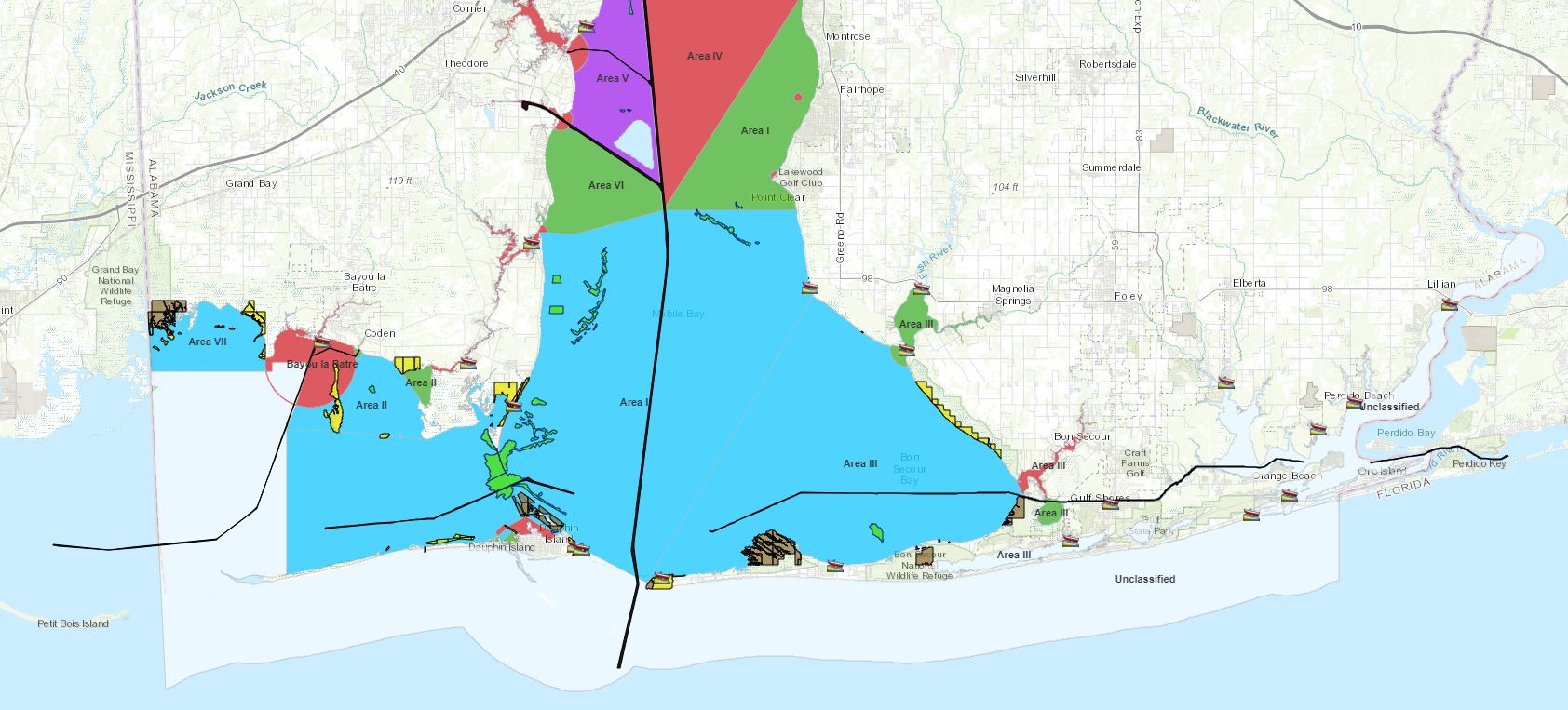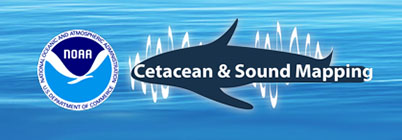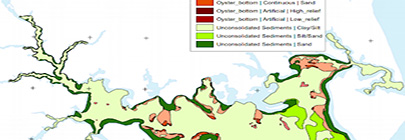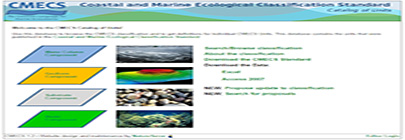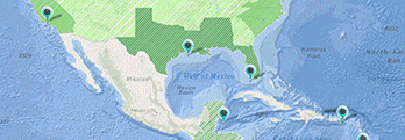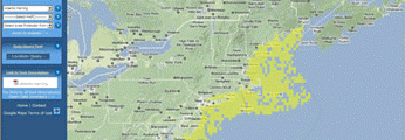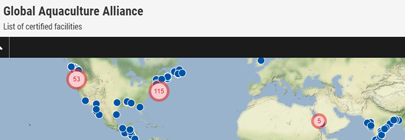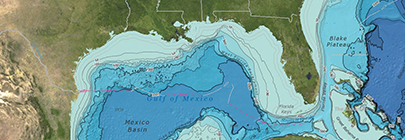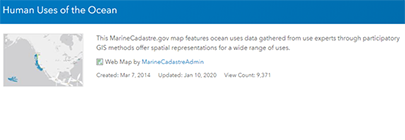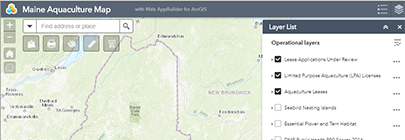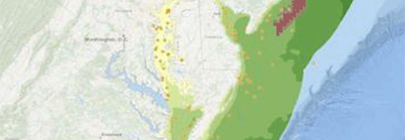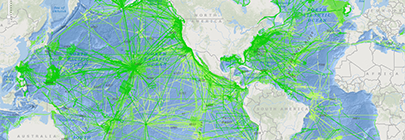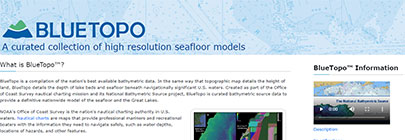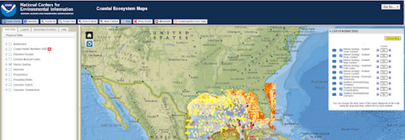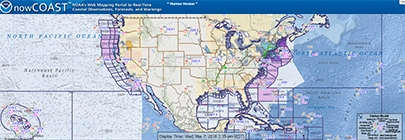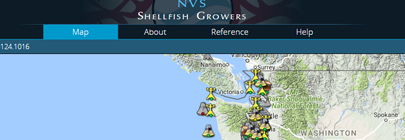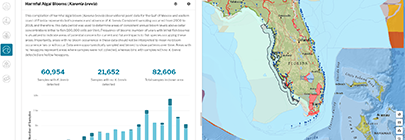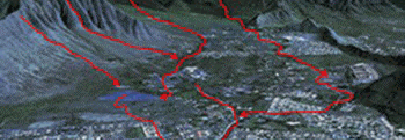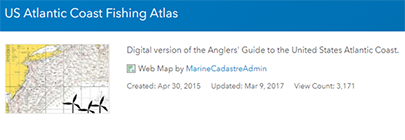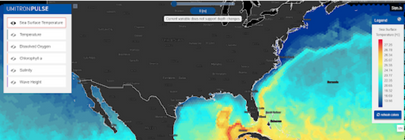Coastal Aquaculture Planning Portal (CAPP)
A Toolbox for Sustainable Aquaculture Coastal Planning and Siting
The Coastal Aquaculture Planning Portal (CAPP) is a toolbox of coastal planning tools designed to assist managers, planners, and industry with sustainable aquaculture development. This toolbox was developed in partnership with Digital Coast, a product of the NOAA National Ocean Service Office for Coastal Management. Explore the portal by filtering Subportal, Keyword, and Region.
As marine aquaculture expands around the world, there is increased concern for impacts to protected species. Documented cases of marine mammal, sea turtle, seabird, and shark interactions with aquaculture installations do exist but are challenging to find. This extensive review summarizes the state of knowledge of protected species interactions with marine fish and shellfish aquaculture installations.
Aquaculture Application: This review is useful for informing industry planning and permitting to develop aquaculture in the open ocean. This work will help advance the science of conservation by synthesizing the state of knowledge and provide managers and industry with more insight to protect the most vulnerable species.
Access the full PDF in the NOAA Institutional Repository.
Actea produces site-specific and regional analysis of ocean climate change and its impact on marine species, including those economically important to coastal aquaculture. Actea’s model has global coverage.
Aquaculture Application: Actea can provide an interactive map tool which displays climate projections to assist with site location. Actea can produce climate risk reports for specific sites and can model aggregate climate risks across multiple sites. Check out the Actea Data Explorer tool demo!
Contributing partners: Actea, Inc., Farallon Institute
This interactive map viewer allows users to view current shellfish harvest restrictions along the Alabama coastline.
Aquaculture application: This map viewer can be used for aquaculture screening and risk communication for lease bed harvest closures.
Tutorial: Download under site selection
Contributing Partners: Alabama Marine Resource Division, Sea Grant
The Mariculture Map is a web-based tool for planning and permitting marine aquaculture projects in Alaska. Here you can view and download environmental, oceanographic and social data layers, create and print custom maps for permit applications, and discover real-time coastal and ocean sensor data.
Aquaculture application: Used for mariculture planning, permitting, and risk reduction for impacts to sensitive species and habitats.
Contributing Partners: AOOS
This map is intended to be a platform for sharing information and data for coastal and marine spatial planning in the Pacific Islands.
Aquaculture application: Development and planning for aquaculture activities.
Contributing Partners: NOAA, BOEM, MarineCadastre, NOAA PIRPB
Can be used to examine near and far field effects of individual or clusters of farms in the coastal shelf where nearshore or open-ocean aquaculture may develop. The software models farms with multiple, separate cages and multiple farm sites to meet this challenge.
Aquaculture application: AquaModel allows for proper planning, siting and management of offshore aquaculture farms to monitor and reduce environmental impacts to marine ecosystems.
Requirements: Technical training and purchase of AquaModel Software
Contributing Partners: EASy
Guide for marine cage culture BMPs in the U.S. Caribbean
Aquaculture application: These BMPs are useful for guiding the management practices of cage culture operations to ensure productivity and environmental stewardship in the U.S. Caribbean.
Contributing Partners: GCFI, Sea Grant, DRNA
View Product
Linking biodiversity occurrence data to the physical and biotic environment provides a framework to formulate hypotheses about the ecological processes governing spatial and temporal patterns in biodiversity, which can be useful for marine ecosystem management and conservation. Bio-ORACLE offers a user-friendly solution to accomplish this task by providing 18 global geophysical, biotic and climate layers at a common spatial resolution (5 arcmin) and a uniform landmask.
Aquaculture application: Oceanographic and biophysical data at depth, helping to determine if needed environmental conditions are in place for five to ten year aquaculture permit.
Contributing Partners: Ghent University, LifeWatch, VLIZ, CCMAR
The Biological and Chemical Oceanography Data Management Office (BCO-DMO) staff members work with investigators to serve data online from research projects funded by the Biological and Chemical Oceanography Sections, the Division of Polar Programs Arctic Sciences and Antarctic Organisms & Ecosystems Program at the U.S. National Science Foundation.
Aquaculture application: Wide range of datasets on different geographical, geophysical, biological, and environmental data to inform aquaculture planning.
Contributing Partners: National Science Foundation
The Blueways Conservation Decision Support Tool offers a wide range of information about ocean resources and management. The focused apps and extensive spatial layers available are valuable tools for enhancing biodiversity, ecosystem-based management, and healthy human activity in the ocean. These resources may serve to support decision-making by marine planners, resource managers, commercial and recreational fishermen, and many other industries using the ocean.
Aquaculture application: Use of spatial technologies and data on existing energy planning, regulated fisheries locations, and regional marine planning to inform aquaculture planning.
Contributing Partners: The Nature Conservancy
Federal outer Continental Shelf (OCS) Sand and Gravel Borrow Areas (Lease Areas) are polygons which are maintained by the Bureau of Ocean Energy Management (BOEM), part of the U.S. Department of the Interior. The polygons define areas where entities that have entered into or have requested a Negotiated Non-Competitive Lease or Memorandum of Agreement with BOEM can dredge sand, gravel or shell resources from the OCS.
Aquaculture application: Aquaculture education, Ocean education.
Contributing Partners: BOEM
CetSound, or Cetacean & Sound Mapping, consists of two mapping tools: CetMap and SoundMap. Both tools aim to assist in evaluating the impacts of man-made noise on cetacean species, which include whales, dolphins, and porpoises.
Aquaculture application: NOAA is developing publicly available tools for assessment, planning and mitigation of noise-making activities over ecologically-relevant scales.
Contributing partners: NOAA
To support Chesapeake Bay native oyster restoration and other benthic habitat assessments requiring seafloor characterization, the NOAA Chesapeake Bay Office has completed acoustic seafloor mapping projects around the Bay.
Aquaculture Application: Planning and siting for shellfish aquaculture.
Contributing Partners: NOAA Chesapeake Bay Office
Translates existing benthic habitat data sets to the Coastal and Marine Ecological Classification Standard (CMECS). Users can then create a file geodatabase containing CMECS component feature layers.
Aquaculture application: The Crosswalk Tool classifies benthic habitat for users to export categorized data, and import into a GIS to assist with aquaculture screening and siting.
Contributing Partners: NOAA OCM
View Product
Zoned tides, relative to a tidal datum, can be constructed by applying time and range correctors to observed water level data from a given NOAA tide station for corrections.
Aquaculture application: Users can view and download tidal corrections for planning of shellfish aquaculture farm locations relative to the needed balance of submerged and exposed gear.
Contributing Partners: National Ocean Service (NOS) Center for Operational Oceanographic Products and Services (CO-OPS)
Use this database to browse the CMECS classification and to get definitions for individual CMECS Units for water column, geoform, substrate, and biotic components. This database contains the units that were published in the Coastal and Marine Ecological Classification Standard.
Aquaculture Application: National framework for organizing information on the physical, biological, and chemical data that are collectively used to define coastal and marine ecosystems.
Contributing Partners: IOCM
Create a map of potential ecological, social, and economic impacts from rising seas and changing climate. Resources are organized under three themes: extreme storms, shoreline change, and sea level rise.
Aquaculture application: Assess, download, and share data on coastal change and potential impacts to coastal aquaculture in the present and future.
Contributing Partners: USGS
Turn complex data into easy-to-understand stories, complete with charts and graphs.
Aquaculture application: Map a coastal county’s use of the ocean and wetlands for economic contributions and potential introduction of new aquaculture for continued and sustainable economic growth.
Contributing Partners: NOAA OCM
The Nature Conservancy examines nature’s role in reducing coastal flood risk. The program consists of an approach, a web mapping tool, and a network of practitioners around the world supporting hazard mitigation and climate adaptation planning.
Aquaculture application: Aquaculture operations and inland infrastructure can be better prepared for extreme events and build resilience into their management framework.
Coastal aquaculture planning, screening, and siting at global, national, regional, and in some cases, local scales.
Contributing Partners: The Nature Conservancy
Create a map of potential ecological, social, and economic impacts from rising seas and changing climate.
Aquaculture application: Map aquaculture coastal planning efforts and evaluate resiliency options.
Contributing Partners: ASFPM, Natural Capital Project, TNC, NOAA OCM, USGS, UCSC, USM
View Product
Interactive decision-support tool for shellfish aquaculture along the Connecticut coastline.
Aquaculture application: The tool is designed to provide information to help potential shellfish farmers determine site feasibility, potential risks, and long-term suitability for particular areas in Connecticut.
Contributing Partners: UCONN, CLEAR, Sea Grant, Connecticut Department of Agriculture
Cormix Is a USEPA-supported mixing zone model and decision support system for environmental impact assessment of regulatory mixing zones resulting from continuous point source discharges. The system emphasizes the role of boundary interaction to predict steady-state mixing behavior and plume geometry.
Aquaculture application: Assists in the site selection of aquaculture facilities located in close proximity to point source discharge.
Contributing Partners: MixZon Inc
The Cultured Aquatic Species Fact Sheet collection provides baseline information of environmental conditions needed for some aquaculture species.
Aquaculture application: Provides a general overview of various aquaculture aspects including production systems, diseases and control measures, production statistics, and market and trade for the most important species in global aquaculture.
Contributing Partners: FAO
A biogeographic classification of the world’s coastal and continental shelf waters following a nested hierarchy of realms, provinces and ecoregions.
Aquaculture application: Descriptive information about ecoregions is useful for planning and development of aquaculture activities.
Contributing Partners: Data Basin, TNC
Map viewer for users to view relative risk of consuming shellfish from specific geographical locations.
Aquaculture application: This map viewer indicates seasonally approved and prohibited areas for shellfish harvest.
Contributing Partners: Delaware Department of Natural Resources and Environmental Control
Allows users to visualize computational data on the rate of shoreline change using multiple historical shoreline positions.
Aquaculture application: Assesses the effects of moving shorelines on nearshore aquaculture siting.
Requirements: Software – ArcGIS 10.X, Download
Contributing Partners: USGS
The Ecological Marine Units (EMU) map seeks to portray a systematic division and classification of physiographic and ecological information about features in the ocean. The explorer brings a fully interactive map to users, of marine ecology that is fully 3D and covers all of the oceans will make it possible for users to navigate through the ocean and observe a wide range of ocean parameters such as salinity and oxygen levels, as you explore from the surface down to the ocean floor.
Aquaculture application: This application allows for coastal managers and the aquaculture industry to have a rough characterization of dissolved chemical components at various depths throughout the World’s oceans. These estimates can aid in screening areas for aquaculture.
Contributing Partners: ESRI
Identify and download the NOAA Nautical Chart needed for a specific planning area. This simplifies the use of electronic navigational charts, and ensures the user has the most up-to-date ocean-use information.
Aquaculture application: Users can access NOAA’s up-to-date nautical charts to assist in aquaculture screening and siting.
Contributing Partners: NOAA OCM
This tool streamlines the task of obtaining and comparing economic data, at both the county and national scale, for the six economic sectors dependent on the ocean and Great Lakes.
Aquaculture application: This interactive tool allows users to quickly access and view summary data for various ocean economies including: living resources, marine construction and transportation, offshore mineral resources, ship and boat building, and tourism and recreation. This can aid users in gauging the economic impacts of new aquaculture operations on U.S. coastal ocean region’s working waterfronts.
Contributing Partners: NOAA OCM
As a response to the unprecedented Deepwater Horizon oil spill in the Gulf of Mexico in 2010, NOAA’s Office of Restoration & Response (OR&R) created an interactive web map to communicate to the public about potential impacts and restoration of the affected coastlines and the Gulf itself.
Aquaculture application: OR&R keeps the ERMA viewer active and updated with various studies completed after the Deepwater Horizon oil spill about impacts to the surrounding Gulf environment. As petroleum products have the potential to bioaccumulate in aquaculture organisms, numerous studies were conducted post-spill, and results are now integrated into the web viewer for visualizations of products. These products include numerous reports for oysters, a major aquaculture species in the Gulf region.
Contributing Partners: NOAA Office of Response and Restoration
Environmental Sensitivity Index (ESI) maps provide a concise summary of at risk coastal resources if an oil spill, or other technological disaster, occurs. Examples of at-risk resources include biological resources (e.g., shellfish beds), sensitive shorelines (such as marshes and tidal flats), and in-water aquaculture assets.
Aquaculture application: Shellfish operators can utilize ESI maps to determine vulnerable locations to technological disasters, such as oil spills, and plan accordingly if a spill were to occur. Proper protective spill equipment (e.g., booms) and actions can be implemented, reducing the environmental consequences of the spill and the cleanup efforts.
Contributing Partners: NOAA NOS Office of Restoration & Response
The Environmental Sensor Map integrates regional, national, and global real-time data across the Integrated Ocean Observing System (IOOS) enterprise. Data from observing systems can be directly accessed through the map. Overall, the map connects to over 31,000 stations providing the latest information on oceanographic and meteorological conditions.
Aquaculture application: Users can visualize real time maritime and atmospheric data, as well as forecasted data, which can be utilized by aquaculture industry and coastal managers for management and planning.
Contributing Partners: IOOS
A downloadable application that estimates the annual rainfall and frequency of runoff from a specified area located within the United States (including Puerto Rico). Estimates are based on local soil conditions, land cover, and historic rainfall records.
Aquaculture application: This software aids shellfish farmers in analyzing local rainwater runoff rates in efforts to site shellfish leases with a decreased risk of closure due to stormwater runoff.
Contributing Partners: EPA
Shows where Endangered Species Act (ESA) threatened coral species can be found in the Gulf of Mexico region and allows the user to measure distance, filter by year and coral species, run spatial analysis, and get background information on data layers that are updated annually.
Aquaculture application: Used for planning, risk reduction, and identification of sensitive species and habitats for aquaculture application.
Display essential fish habitat areas and the restrictions, or needed data associated with those areas. Users can also query spatial information from fishery management plans.
Aquaculture application: Identify potential sensitive habitats, and information for EFH consultations, to identify and report any sensitive habitats overlapping with siting of new aquaculture infrastructure.
Contributing Partners: NOAA Office of Habitat Conservation
View Product
Allows users to view, retrieve, visualize and analyze a wide range of estuarine data from multiple authoritative sources.
Aquaculture application: Interactive software application for water quality conditions for screening and siting aquaculture.
Requirements: Download
Contributing Partners: EPA
View Product

The FAO Guidance on spatial technologies for disaster risk management in aquaculture provides concepts and technical information to raise awareness and improve knowledge of the spatial technologies available to decision-makers, managers and technical personnel involved in disaster risk management (DRM) for aquaculture. Also includes:
Aquaculture application: Used for planning, risk reduction, preparedness, and use of spatial technologies for aquaculture application.
The State of World Fisheries and Aquaculture (SOFIA) is the flagship publication of the FAO Fisheries and Aquaculture Department. This premier advocacy document is published every two years to provide policy-makers, civil society and those whose livelihoods depend on the sector a comprehensive, objective and global view of capture fisheries and aquaculture, including associated policy issues.
Aquaculture application: Compiles a world perspective on capture fisheries and aquaculture providing updated information on production, policy changes across the globe, and innovative technology.
Contributing Partners: FAO
The National production page includes a map on aquaculture production of aquatic animals for human consumption (tonnes) in 2009.
Aquaculture application: These mapping efforts depict a global overview of aquaculture production by category (fish, shellfish, etc.) helping the user assess the global market.
Contributing Partners: FAO
FishStatJ is a downloadable desktop application providing users with access to a variety of fishery statistical datasets.
Aquaculture application: Allows decision makers and stakeholders access to statistical datasets browsing, data mining, charting and reporting, filtering, grouping and aggregation aquaculture and fisheries related data.
Contributing Partners: FAO
This international portal grants users access to spatial data and information to support decision making. GeoNetwork opensource allows to easily share geographically referenced thematic information between different organizations. Search for FAO Fisheries and Aquaculture maps and data within this viewer.
Aquaculture application: Tool provides worldwide geo-spatial data in support of agricultural growth and development. Maps of farm gate value, global scale aquaculture trends, and other aquaculture-relevant data visualizations.
Contributing Partners: FAO
160,000 datasets (data, web services, press releases, articles, and more) registered to facilitate a unique, geospatial-oriented social experience, with shared resources at its core. Use these resources to collaborate with other users, solve critical problems, and foster science-based decision-making.
Aquaculture application: One-stop shop for geospatial data that can be used in collaborative aquaculture planning and siting efforts.
Contributing Partners: GeoPlatform.gov
A global map depicting all the aquaculture facilities that have the Best Aquaculture Practices (BAP) Certification. These aquaculture operations have met certain quality standards to receive the BAP certification.
Aquaculture application: The map identifies the locations of all BAP-certified farms, hatcheries, feed mills, processing plants and repackaging plants.
Contributing Partners: Global Aquaculture Alliance
View Product
Shows the locations of coral observations as well as current and proposed HAPCs in the Gulf of Mexico where dredge fishing gear is prohibited.
Aquaculture application: Used for planning, risk reduction for impacts to the ecosystem, and identification of sensitive habitats to avoid for aquaculture application.
GreenWave is a non-profit organization that trains and supports ocean farmers in the era of climate change, working with coastal communities around the world to create a blue economy. This team replicates and scales regenerative ocean farms, such as shellfish and macroalgae, to create jobs and protect the planet. Check out the trailer, and register for free to find out more!
Aquaculture application: GreenWave’s 10-year goal is to provide training, tools, and support to a baseline of 10,000 regenerative ocean farmers to catalyze the planting of 1 million acres and yield meaningful economic and climate impacts.
Contributing Partners: GreenWave
This document is a comprehensive list of available Federal agencies and services that can assist in the development and execution of aquaculture in the United States.
Aquaculture application: This document provides valuable information regarding Federal resources, which will assist farmers in their preparation and operation of U.S. based aquaculture related businesses.
Contributing Partners: National Science and Technology Council
The Gulf AquaMapper is a web-mapping application designed to assist managers in identifying suitable areas for aquaculture development in the Gulf of Mexico. The application provides high resolution maps to improve the coordination and transparency of permits and siting, which in turn reduce planning costs on industry and regulatory agencies and allow for more investment opportunities in domestic seafood production.
Aquaculture application: Online spatial screening tool consisting of aquaculture relevant data for the Gulf of Mexico.
Contributing Partners: NOAA, Marinecadastre.gov, OCM
The GOMAportal.org is a metadata catalog and data repository for Gulf of Mexico related geospatial datasets. Allows you to browse data for regulatory, oceanographic and biological information.
Aquaculture application: Spatial technologies for disaster assessment, emergency response, and planning for coastal aquaculture in the Gulf of Mexico.
Contributing Partners: Esri
GOMAportal.org is a metadata catalog and data repository for Gulf of Mexico related geospatial datasets.
Aquaculture application: Users can identify and research data available for planning, screening, and siting for coastal aquaculture in the Gulf of Mexico.
Contributing Partners: Gulf of Mexico Alliance, GOMA Ecosystems Integration and Assessment Priority Issue Team, Harte Research Institute for Gulf of Mexico Studies, NOAA National Coastal Data Development Center
State Partners: Alabama Department of Conservation and Natural Resources, Marine Resources Division, Florida Fish and Wildlife Conservation Commission Fish and Wildlife Research Institute, Louisiana Department of Wildlife and Fisheries, Mississippi Department of Marine Resources
University Partners: Florida Institute of Oceanography, University of New Orleans Pontchartrain Institute for Environmental Sciences, University of Southern Mississippi Gulf Coast Geospatial Center
Created by utilizing 3D seismic data which covers more than 90,000 square miles of enhanced resolution bathymetry data for the deep waters of the Gulf of Mexico.
Aquaculture application: Enhanced high resolution imagery of deepwater bathymetry allows for a more informed aquaculture site suitability analysis. High-resolution, accurate bathymetry increases accuracy of estimates for oceanographic, habitat-related, and hydrographic parameters within a given area.
Contributing Partners: BOEM
Requirements: Download
The GOMOD platform includes a comprehensive map of seagrass extent for the entire Gulf of Mexico, curated theme maps for key coastal and ocean management topics of interest to Gulf stakeholders, a data explorer where users can choose their own datasets of interest, and access to a suite of regional data tools developed by GOMA.
Aquaculture application: With themed maps, users can explore bathymetry, offshore energy, priority habitats, and seagrass data. Assessments of environmental factors and infrastructure can be used in collaborative aquaculture habitat suitability planning and siting efforts.
Contributing Partners: GOMA
These data show ocean use patterns (general use areas and dominant use or hotspot areas) for 27 separate uses of the ocean off the state of California. The data set includes input from commercial and recreational fisheries, offshore energy, tourism, ports, shipping and navigation, national security, recreational users (e.g., surfers, boaters, wildlife viewers, etc.), and conservation groups.
Aquaculture application: Development and planning for aquaculture activities.
Contributing Partners: MarineCadastre, NOAA
IOOS data comes from a variety of technologies or data collection systems. While types of data available through any one of our 11 regional associations may vary depending on the local area, the national IOOS data products include data collected from buoys, high frequency radar systems and gliders. Modeling teams across regional associations also create data products including physical and environmental models of coastal systems.
Aquaculture Application: Useful for visualizing oceanographic conditions and forecasting for aquaculture development.
Contributing Partners: NOAA IOOS
Free, open-source software models where users may map and value goods and services form the ecosystem that help to sustain and fulfill life.
Aquaculture application: Enables decision makers to assess the trade-offs associated with alternative choices, where investment in natural capital (aquaculture), can enhance human development and conservation in terrestrial, freshwater, and marine ecosystems.
Requirements: Download software
Contributing Partners: Natural Capital Project
View Product
IOOS is an integrated network of people and technology gathering observing data and developing tracking and predictive tools to benefit the economy, the environment, and public safety at home, across the nation, and around the globe.
Aquaculture application: IOOS buoys and sensor stations provide real-time data and data products for numerous areas around the nation. Many of the atmospheric and oceanographic parameters are needed for siting and monitoring aquaculture operations.
Contributing Partners: NOAA
This website hosts the multibeam bathymetry and backscatter synthesis for the main Hawaiian Islands. Data has been collected and processed for visualization of all available bathymetry data for the Main Hawaiian Islands.
Aquaculture Application: Bathymetric data can be used for screening and planning of aquaculture activities.
The map viewer displays Maine aquaculture leases and licenses with links to basic information, and Maine shellfish growing areas with links to their water quality classification information.
Aquaculture application: The map viewer can be used for aquaculture screening and risk communication for lease bed harvest closures.
Contributing Partners: The state of Maine, Maine Department of Marine Resources
ArcGIS extension that Identifies suitable locations for planting native marsh grasses during coastal wetland restoration.
Aquaculture application: Identifies areas where shellfish aquaculture siting may interact with wetland restoration.
Requirements: ArcGIS software and Spatial Analyst Extension
Contributing Partners: NOAA CO-OPS
View Product
This story map highlights the various types of marine aquaculture in the U.S. The map is not exhaustive and does not feature every domestic farm. It does provide a general overview to highlight the general landscape of marine aquaculture production in California and the U.S.
Aquaculture application: Learn about where, and what type of aquaculture is occurring around the nation.
Contributing Partners: Aquarium of the Pacific
This portal contains ecological datasets including marine environmental, benthic habitats, fishes, sea turtles, marine mammals and seabirds off the Main Hawaiian Islands.
Aquaculture application: Datasets may be used to assist in siting offshore aquaculture operations in federal waters.
Contributing Partners: NOAA/NCCOS, BOEM
Provides an assessment of marine cage culture and environmental interactions
Aquaculture application: This technical overview is a state of science analysis providing information about the potential environmental impacts of finfish cage culture systems, and guidance for best farm practices for sustainable farming. Additional guidance is provided for permitting and monitoring for U.S. regulatory agencies, as well as for coastal stakeholders aiming to make informed aquaculture decisions.
A collection of over 250 geoprocessing tools and data products in one GIS toolbox that can easily be imported into a user’s GIS environment.
Aquaculture application: Coastal aquaculture planning, screening, and siting at global, national, regional, and in some cases, local scales.
Requirements: ArcGIS 10.x
Contributing Partners: Duke University, NOAA OCM
View Product
Collaboration to produce “base layer” predictive model products with associated uncertainty products for 29 marine mammal species or species guilds and 40 avian species, and three geospatial products for 82 fish species.
Aquaculture application: Decision support tools for aquaculture coastal managers and stakeholders to view numerous sets of biological data, as well as derived data products.
Contributing Partners: Duke University (MGEL), NOAA, NCCOS, Loyola University
Supplies baseline ocean planning data and allows for high quality visualizations for marinecadastre.gov data. Data and metadata can be viewed and downloaded as well.
Aquaculture application: Download and visualize 249 various data layers for coastal planning, including spatial data for the Nation’s aquaculture industry (search for the “aquaculture” layer).
Contributing Partners: BOEM, NOAA OCM
View Product
Supports conservation planning design and evaluation through the development of multiple-use areas and plans for natural resource management.
Aquaculture application: Employ this tool to meet ecological, social, and economic objectives for coastal aquaculture planning.
Requirements: Download
Contributing Partners: University of Queensland Australia
Interactive decision-support tool for the Maryland coastline assisting shellfish growers in siting and gauging risk for aquaculture operations by providing conditions and resource conflicts based on existing datasets.
Aquaculture application: The tool is designed to provide information to help potential shellfish farmers determine site feasibility, potential risks, and long-term suitability for particular areas in Maryland.
Contributing Partners: Maryland DNR
View Product
Interactive coastal ocean decision-support tool for the Massachusetts coastline providing many data layers pertinent to coastal management, including spatiotemporal information of shellfish aquaculture.
Aquaculture application: The tool is designed to aid in ocean planning. Included are layers for shellfish bed closures, and a site suitability layer for certain shellfish species.
Requirements: Must search for shellfish and shellfish suitability
Contributing Partners: MassGIS
View Product
This highly-functional online toolkit and resource center consolidates available data and enables a multitude of stakeholders to visualize and analyze ocean resources and human use information such as fishing grounds, recreational areas, shipping lanes, habitat areas, and energy sites, among others.
Aquaculture application: MARCO serves as a platform to engage all stakeholders in the five coastal mid-Atlantic states, assembling much of the essential data needed for aquaculture screening in the region. MARCO uses a customized, state-of-the-art mapping and visualization technology to better engaged all stakeholders in the ocean planning process.
Contributing Partners: MARCO
View Product
To provide support for local jurisdictions and developers in their efforts to work with the U.S. military to complete Joint Land Use Studies and other development efforts on / around DoD lands, the following webpage provides links to GIS datasets and online resources from which to download useful, planning-based geospatial data for further analysis.
Aquaculture application: Military Compatibility with aquaculture development.
The National AquaMapper provides aquaculture-relevant data for offshore waters of the United States in one easy-to-use map viewer.
Aquaculture application: This tool is designed to support and inform screening of ocean areas for aquaculture through visualization of numerous siting parameters.
Contributing Partners: NCCOS
The National production page includes a map on aquaculture production of aquatic animals for human consumption (tonnes) in 2009.
Aquaculture application: This map depicts a global overview of aquaculture production by category (fish, shellfish, etc.) helping the user asses the global market.
Contributing Partners: FAO
View Product
Allows users to assess (i.e., calculate) and better understand cumulative effects for numerous management scenarios (e.g., climatic variability, site conflicts). The tool supports adaptive management by integrating monitoring data and new knowledge or models to better understand how well an area is meeting conservation objectives.
Aquaculture application: This tool allows users to Integrate conservation tools and practices with aquaculture screening and siting in the pursuit of an ecosystem approach to aquaculture.
Requirements: Monetary: Non-commercial user – free; commercial user – $2500 for the first year; Software: ArcGIS 10.X and spatial analyst extension
Contributing Partners: NatureServe
View Product
The North Carolina Division of Marine Fisheries maintains 42 ocean artificial reefs and 22 estuarine reefs, 15 of which serve as oyster sanctuaries.
Aquaculture application: Useful to visualize existing oyster sanctuary locations and other artificial habitats that would accommodate aquaculture planning.
Contributing Partners: NCDEQ
Allows users to interactively view data, aerial imagery, dive photography, underwater video and related publications developed for the benthic habitat mapping of many U.S. coral reefs. In addition to viewing benthic habitat data, users can examine the attributes of the data and view different thematic representations. Photos and videos taken during dive missions are linked to the location of the dives.
Aquaculture application: The application allows aquaculture coastal managers and industry to visualize the benthic habitat, and make screening and siting decisions based on benthic composition.
Contributing Partners: NOAA, NCCOS
Description: Search geographically for studies and data available from NOAA’s NOS NCCOS. This map viewer allows users to search, locate, download, and utilize data for a chosen area of interest.
Aquaculture application: Users can search for data and information on scientific studies carried out within an area of interest for aquaculture operations. Data needed can then be downloaded in a number of user-friendly formats.
Contributing Partners: NOAA, NCCOS
The interactive viewer allows visualization of New Hampshire shellfish harvest areas, the status of those areas, and licenses required for harvesting various shellfish species.
Aquaculture application: This viewer allows for quick reference to which species and in which areas can be harvested along the New Hampshire coastline.
Contributing Partners: New Hampshire Department of Environmental Services
This interactive map viewer allows users to view shellfish harvest restriction and areas with closures.
Aquaculture application: This map viewer indicates seasonally approved and prohibited areas for shellfish harvest.
Contributing Partners: New Jersey Department of Environmental Protection
This interactive map shows year-round and seasonal shellfish closures, conditional harvest areas, commercial shellfish harvest zones, aquaculture lease sites, DEC water sampling stations, and more!
Aquaculture application: This online tool gives you the ability to view commercial and recreational harvest and permit information, restoration initiatives, and harmful algal bloom data so the user can determine safe and sustainable areas, limits, and seasonality to collect shellfish.
Contributing Partners: New York State Department of Environmental Conservation
The Geographic Information Gateway provides public access to data, real-time information, interactive tools, and expert knowledge relevant to the Office of Planning, Development & Community Infrastructure (OPDCI) activities throughout New York State.
Aquaculture Application: The Gateway map viewer allows users to visualize and explore geographic data, learn about case studies that improve decision-making, access real time oceanographic information (water quality, tides), and improve consistency with planning and permitting for aquaculture. This app is an excellent complement to the New York State Dept of Environmental Conservation’s Public Shellfish Mapper and includes additional information on aquaculture sites.
Contributing partners: New York Department of State
Users can preview coastal aquaculture research NOAA conducts in many coastal states of the nation. This interactive map viewer provides a comprehensive overview of aquaculture research projects carried out by NOAA aquaculture scientists.
Aquaculture application: Users can explore the many exciting projects conducted by NOAA scientists, glimpsing into new and emerging research and technology being carried out to ensure sustainable and environmentally conscious aquaculture for the future.
Contributing Partners: NOAA National Marine Fisheries Service
View Product
This interactive viewer allows for the identification of NOAA bathymetric data for both visualization and download. The viewer contains single-beam tracklines, multibeam surveys and mosaics for data visualization, the NOS hydrographic surveys, BAG footprints and shaded imagery, digital elevation models (DEMs), and coastal LiDAR datasets available.
Aquaculture application: Coastal managers and the aquaculture industry can identify potential bathymetric data available for a specific location. This data can be downloaded and used for planning purposes.
For combined bathymetric/topographic data, estuarine bathymetry, and more go to the NCEI World Data Service for Geophysics.
Contributing Partners: NOAA NCEI
BlueTopo is a compilation of the nation’s best available bathymetric data. BlueTopo details the depth of lake beds and seafloor beneath navigationally significant U.S. waters.
Aquaculture application: BlueTopo displays bathymetry in a layer behind a nautical chart, which provides more context to the user and encourages a deeper understanding of the seafloor. This is helpful when determining aquaculture gear type(s) that would be compatible in those areas.
Contributing Partners: NOAA Office of Coast Survey
A compilation of geospatial data to create a national framework for coastal and marine spatial planning, complete with data, tools, and information to bolster transparent, science-based decision-making to enhance regional economic, environmental, social, and cultural well-being.
Aquaculture application: Provides access to data and a platform for collaborative, regionally-based planning and aquaculture siting.
Contributing Partners: NOAA
The “all-in-one” NOAA CoastWatch/OceanWatch Data Portal for viewing products and accessing data files has been updated with new features and more data: Visualize, layer, geographically and temporally subset data products and download files for your selections.
Aquaculture Application: Useful to observe and predict oceanographic trends for aquaculture screening and planning.
The CHAMP Portal is a query tool for accessing oceanographic and meteorological data from the CHAMP database. This database defines many “stations,” or latitude-longitude pairs, which may be physical observation platforms of some kind (CREWS pylons, SEAKEYS light towers, CCCCC buoys, or other) or “virtual” stations at points of interest for which remotely-sensed parameters are collected and stored.
Aquaculture application: Environmental assessments of coral habitat queries can be used in collaborative aquaculture habitat suitability planning and siting efforts.
Contributing Partners: NOAA
Story map documenting how shellfish farms interact with the environment.
Aquaculture application: Provides information on sustainable seafood development by fostering marine aquaculture production, while also protecting our oceans and coastal ecosystems that aquatic species call home. Aquaculture education, ocean education.
Contributing Partners: NMFS
A compilation of shellfish permitting processes for placement of structures (federal process), general permitting info, guidance documents, flow charts, etc. (local, state, federal process) and regulations (state).
Aquaculture application: This compilation of information provides the knowledge needed for future shellfish farmers to understand the permitting process and site a shellfish lease within their state. Check out this article, “Office of Aquaculture Updates State Aquaculture Regulatory Inventory Resources” for more information.
Contributing Partners: NOAA National Marine Fisheries Service
NOAA Fisheries’s science-based conservation and management of sustainable fisheries, marine mammals, endangered species, and their habitats have become global models for marine stewardship and sustainability.
Aquaculture application: Effective science-based conservation and management are essential to ensuring sustainable domestic seafood production, maintaining and enhancing fishing opportunities, recovering protected species, and safeguarding ecosystem health.
Contributing Partners: NMFS
Based on the idea of a traditional atlas, the Gulf of Mexico Data Atlas provides an interactive platform to view and download many data layers pertinent to ocean planning. Data layers are grouped by theme, including physical, biotic, living marine resources, socioeconomic conditions, environmental quality, and jurisdictions in the U.S. portion of the Gulf of Mexico.
Aquaculture application: The interactive Gulf of Mexico Data Atlas provides numerous themed data layers that users can visualize and download for aquaculture screening in the Gulf of Mexico.
Contributing Partners: NOAA NESDIS; NOAA NCEI
View Product
The Spatial Prioritization Widget is a tool to gather mapping priorities from stakeholders in a study area. This customizable tool can be configured to identify not only the desired locations and the temporal priorities of the respondents, but also their rationales to justify these decisions or the type of mapping products they need.
Aquaculture application: Aquaculture education, ocean education. The data can be further analyzed to identify consensus areas of highest priority.
Contributing Partners: NCCOS
This Portal provides access to coastal ecosystem maps (physical data, biotic data, living marine resources, socioeconomic conditions, environmental quality, and jurisdictions), images, and technical reports from research funded by NOAA’s Centers for Environmental Information (NCEI).
Aquaculture application: Environmental assessments of physical, biotic, and living marine resources reports can be used in collaborative aquaculture habitat suitability planning and siting efforts.
Contributing Partners: NOAA
The Future of Ocean Farming: an introduction to marine aquaculture, breeding, rearing, and harvesting of aquatic plants and animals.
Aquaculture application: Aquaculture education, ocean education.
Contributing Partners: NOAA
This page is a suite of 73 tools that can be used for coastal planning and development, community resilience projects, climate adaptation, and more. Data and information contained here provides coastal managers the information and tools they need to balance society’s environmental, social, and economic goals.
Aquaculture application: Wide range of geospatial datasets and tools on different geographical, economic, and environmental data to inform coastal and aquaculture planning in the U.S. EEZ.
Contributing Partners: NOAA, TNC, and various state, federal, regional, and academic institutions.
This data portal hosted by the SWFSC provides data relevant for the conservation and management of the living marine resources in the California Current, Pacific Ocean and in Antarctica.
Aquaculture application: Used for planning, risk reduction, and identification of sensitive species and habitats for aquaculture application.
Contributing Partners: NMFS
The Center for Operational Oceanographic Products and Services (CO-OPS) and its predecessors have gathered oceanographic data along our nation’s coasts for over 200 years to provide accurate forecasts. Here you can access those data and the associated map products.
Aquaculture application: Real time maritime and atmospheric data, as well as forecasted data, can be utilized by the aquaculture industry, and coastal managers, for management and planning.
Contributing Partners: NOAA CO-OPS
Users can visualizes numerous environmental variables at various depths and temporal distillations across the globe. The tool uses data from NOAA’s vast archives of satellites, climate models, and the NOAA Ocean Atlas.
Aquaculture application: Aquaculture coastal managers and industry can visualize and find values for numerous climatologies distilled by month, season, or year, and at numerous depths. This information can then be used for screening-level planning for aquaculture operations.
Training: Tutorial video
Contributing Partners: NOAA National Visualization Lab
Users can identify and download water column sonar data, the acoustic backscatter from the near-surface to the seafloor, to ascertain physical and biological characteristics of the seafloor including the spatial distribution of plankton, fish, methane seeps, and underwater oil plumes.
Aquaculture application: Coastal managers and the aquaculture industry can identify water column sonar data available for a specific location. This data can be downloaded and used for planning purposes.
Contributing Partners: NOAA NCEI
Visualize wind speed, direction, wave height, and wave period with real time data gathered 4 times daily. Wind wave modeling attempts to depict the sea state and predict future environmental conditions.
Aquaculture application: Aquaculture education, ocean education.
Contributing Partners: NCEP
This application can be used to view, query and explore the MPA Inventory, a database compiled by NOAA’s Marine Protected Areas Center that catalogs information on over 1600 marine protected areas in U.S. waters.
Aquaculture Application: Used for coastal planning, risk reduction for impacts to the ecosystem, and identification of sensitive species and habitats to avoid during aquaculture development.
Contributing Partners: NOAA
Interactive decision-support tool for the North Carolina coastline that will assist new or current growers in siting new or expanding shellfish operations.
Aquaculture application: The tool is designed to provide information to help potential shellfish farmers determine site feasibility, potential risks, and long-term suitability for particular areas in North Carolina.
Contributing Partners: UNCW
View Product
Shows real-time wind, weather, precipitation, air temperature, relative humidity, sea level pressure and inundation for Northeast coastal U.S. states.
Aquaculture application: Used for weather forecasting, planning, preparedness, and use of spatial technologies for aquaculture application.
Contributing Partners: University of Massachusetts, Dartmouth College, Woods Hole Oceanographic Institution
This interactive map viewer and data portal provide a comprehensive suite of up-to-date aquaculture relevant data, themed maps for the Northeastern United States (New York to Maine).
Aquaculture application: The application has many of the data layers needed to make relevant coastal aquaculture (shellfish, finfish, and algae) planning decisions at the region to local level. An additional case study of offshore shellfish aquaculture presents an excellent example of proper planning for sustainable aquaculture.
Contributing Partners: Northeast Ocean Data
These data highlight a number of major species groups, habitats, and processes in the Northwest Atlantic and include coastal analyses, benthic habitats, ecological marine units, and multiple fish, mammal and sea turtle analyses.
Aquaculture application: Development and planning for aquaculture activities.
Contributing Partners: MarineCadastre, TNC
NowCOAST provides situational awareness on present and future environmental conditions for coastal and marine users by integrating data and information from across NOAA, other federal agencies and regional ocean and weather observing systems. Users can assess present conditions by creating maps of the latest in-situ weather/marine weather observations for the last few hours. In terms of future conditions, users can obtain maps of critical weather and marine weather advisories, watches, and warnings, weather forecasts, tropical cyclone track and intensity forecasts, and forecast guidance of water levels, temperature, salinity, and currents from oceanographic forecast models.
Aquaculture application: Current and forecast meteorological products available on NowCOAST help to site and monitoring coastal aquaculture operations.
Contributing Partners: NOAA/NOS
Interactive map viewer for shellfish farmers in the Pacific Northwest coastal region. This map viewer includes meteorological, physical and chemical oceanographic parameters both in real time, hincast, and forecast models. For more general information and forecasting there is the Data Explorer.
Aquaculture application: This allows shellfish growers in the Pacific Northwest to monitor current and forecasted conditions of the coastal waters that may impact farm performance.
Contributing Partners: NANOOS
View Product
Ocean Biogeographic Information System Spatial Ecological Analysis of Megavertebrate Populations, is a spatially referenced online database, aggregating marine mammal, seabird, sea turtle and ray & shark observation data from across the globe.
Aquaculture application: Assists aquaculture planners and stakeholders, in siting proper locations that will have the least impact on marine mammals, sea turtles and other protected species.
Contributing Partners: Census of Marine Life, Marine Spatial Ecology Lab
This interactive map viewer and data portal displays real-time data collected from NOAA Integrated Ocean Observing System (IOOS) buoys and stations. The map viewer displays multiple parameters to include water quality data, weather data, geographical features, biological data and more for the southeastern United States (North Carolina to Florida). Data displayed in the viewer can also be downloaded by the user through the portal feature.
Aquaculture application: This interactive portal allows users to view biological, chemical, physical, meteorological, and geographical parameters for screening aquaculture locations for compatible conditions for potential aquaculture operations.
Draw a custom area anywhere in U.S. waters or pick from a predefined list of locations to get instant custom reports. Reports include descriptive infographics and supporting data that can be used for offshore planning, permitting, environmental review, public relations, and more. New features allow printing by industry, sharing, and adding custom coordinates.
Aquaculture application: Explore your ocean neighborhood, and use this decision support tool to evaluate your coastal and ocean project area to plan for aquaculture development.
By providing model inputs, users will be able to simulate an oyster farm for 10 years and make informed financial decisions about an oyster aquaculture business.
Aquaculture application: Being able to accurately determine cost and return in business allows you to plan to maximize potential profit and determine expenses, cash flow and other important aspects of management. In a business with as many risks as aquaculture, this is a wise choice to begin your business planning. This online tool will give you the opportunity to do “what if” scenarios when planning your business. As you gain more accurate figures from the operation of your business it will be a valuable tool to track and make better projections for fine tuning it.
Contributing Partners: University of Maryland Extension, Maryland Sea Grant
Online interactive map interface to support visualization of real-time satellite data to understand climate variability and manage U.S. coastal resources.
Aquaculture application: Remote sensing, observational, modeled data, bathymetry, biological, forecasts, and navigational data for the waters surrounding the Hawaiian Islands.
Assessment of protected species (marine mammals, sea turtles, and birds) interactions with marine aquaculture around the globe.
Aquaculture application: This state of science analysis provides information for environmental assessments and consultations for aquaculture permitting.
Contributing Partners: NOAA, NOS, NCCOS
View Product
Measure potential runoff, nonpoint source pollution, and erosion.
Aquaculture application: Assess the potential for erosion and pollution from runoff on water quality in possible aquaculture development areas.
Contributing Partners: NOAA OCM
View Product
This interactive map viewer allows users to view current shellfish harvest restrictions along the Rhode Island coast.
Aquaculture application: This map viewer can be used for aquaculture screening and risk communication for lease bed harvest closures.
Contributing Partners: Rhode Island Department of Environmental Management Shellfish Sanitation Program
Users can access fisheries and fisheries-related data at spatial scales that have ecological and policy relevance, such as by Exclusive Economic Zones, High Seas, or Large Marine Ecosystems.
Aquaculture application: This interactive application gives users statistics and visualizations for fisheries and related-data for specific country’s Exclusive Economic Zone (EEZ), and can compare amongst countries to create a global view of current fisheries conditions
Contributing Partners: United Nations (FAO) FishStat database
An interactive portal that displays multiple parameters to include, water quality, weather data, geographical features, essential fish habitat and more.
Aquaculture application: This interactive portal allows you to view biological, chemical and geographic parameters for the siting of aquaculture.
Contributing Partners: SECOORA, IOOS
View Product
These maps show current and potential hazards to shellfish aquaculture along Virginia’s coastline.
Aquaculture application: These maps allow shellfish farmers in Virginia to make informed decisions about the siting of their leases based off current and potential water quality hazards, which could potentially reduce oyster and clam mortalities.
Contributing Partners: VIMS, CCRM
View Product
This map highlights several major coastal and marine species and habitats for the South Atlantic Bight (North Carolina to the Florida Keys). Building on a diverse suite of available regional and state data, the map shows the regional distribution and status of seafloor habitats and coastal systems.
Aquaculture application: Development and planning for aquaculture activities.
Contributing Partners: MarineCadastre, TNC
A compilation of permitting process for placement of shellfish structures (federal process), general permitting info, guidance documents, flow charts, etc. (local, state, federal process) and regulations (state).
Aquaculture application: This compilation of information will provide the knowledge needed for future shellfish farmers to properly permit and site a shellfish lease within their state.
Contributing Partners: NOAA National Marine Fisheries Service
View Product
This interactive map viewer allows users to view current shellfish harvest restrictions along the Texas coastline.
Aquaculture application: This map viewer can be used for aquaculture screening and risk communication for lease bed harvest closures.
Contributing Partners: Texas Department of Health and Human Services
This tool was created to quantitatively assess marine life and habitats based on data from the regional data portals to support environmental impact assessments related to wind energy development offshore. “Flags” are intended to draw attention to significant marine features in the Area of Interest (AOI) that may need monitoring or mitigation.
Aquaculture application: Environmental assessments of benthic, pelagic, and species of interest (e.g., marine mammals, birds, fish, invertebrates) can be used in collaborative aquaculture or offshore wind habitat suitability planning and siting efforts.
Contributing Partners: The Nature Conservancy
This is a digital conversion of the National Marine Fisheries Service original hardcopy anglers’ atlases between the years of 1974–1976 to assist the Bureau of Ocean Energy Management (BOEM) in marine spatial planning efforts, specifically the siting of renewable energy projects on the outer continental shelf (OCS). Other elements from this guide have been pulled out into geospatial data including caution points, lines, and areas, as well as a digital map index.
Aquaculture application: Development and planning for aquaculture activities.
Contributing Partners: MarineCadastre, NMFS
Compiles, analyzes, and makes accessible information on the nation’s transportation systems; collects information on intermodal transportation and other areas as needed; and improves the quality and effectiveness of DOT’s statistical programs through research, development of guidelines, and promotion of improvements in data acquisition and use.
Aquaculture application: Aquaculture education, ocean education.
Contributing Partners: USBTS
Discover and access data, information, and decision tools related to our ocean, coasts, and Great Lakes. The National Ocean Council provides this site to support regional marine planning efforts across the country and to create a convenient place for anyone to find out more about our marine, coastal, and Great Lakes environments.
Aquaculture application: Aquaculture education, Ocean education.
NEPAssist is a tool that facilitates the environmental review process and project planning in relation to environmental considerations. The web-based application draws environmental data dynamically from EPA Geographic Information System databases and web services and provides immediate screening of environmental assessment indicators for a user-defined area of interest. These features contribute to a streamlined review process that potentially raises important environmental issues at the earliest stages of project development.
Aquaculture application: Environmental assessments indicators from GIS data that can be used in collaborative aquaculture planning and siting efforts.
Contributing Partners: ESRI, USEPA OAR, USEPA OAQPS
Search and download real-time, delayed-mode, and historical data for in situ and remotely-sensed physical, chemical, and biological observations, compare datasets across regions and disciplines, generate and share custom data views, link to information about protocols, methods and best practices for biological observing, and access a full suite of tools developed with a broad range of IOOS and MBON partners.
Aquaculture application: Remote sensing, observational, modeled data, bathymetry, biological, forecasts, and navigational data for the waters surrounding the Hawaiian Islands.
Provides access to boundaries of over 1600 MPAs, their classification, use restrictions, and associated spatial data for all marine protected areas.
Aquaculture application: User’s can visualize marine protected areas, determine if these areas prohibit aquaculture, and summarize data in a way meaningful to them.
Contributing Partners: NOAA MPA Center
View Product
AIS data are collected by the U.S. Coast Guard through an onboard navigation safety device that transmits and monitors the location and characteristics of large vessels in U.S. waters in real time. This Portal allows the user to view that traffic by type of vessel (e.g., cargo, fishing, military, passenger, pleasure, tanker, tow).
Aquaculture application: The user can view patterns of vessel traffic over time to ensure that potential aquaculture development will not conflict with areas of frequent vessel traffic or coastal operations.
Contributing Partners: USCG
This service provides free and open marine data and services dedicated to aquaculture, enabling marine policy implementation, and supporting Blue Growth and scientific innovation. This Portal allows the user to view sea surface temperature, ocean temperature, dissolved oxygen, chlorophyll a, salinity, and wave height.
Aquaculture application: Environmental assessments of physical and oceanographic data queries can be used in collaborative aquaculture habitat suitability planning and siting efforts.
Contributing Partners: E.U. Copernicus Marine Service
Vertically transforms geospatial data between a variety of tidal, orthometric, and ellipsoidal datums, for high-resolution data products
Aquaculture application: Accurately map areas for aquaculture siting, and create high-resolution bathy topo maps through VDatum transformation.
Contributing Partners: NOAA CO-OPS, NOAA NGS, NOAA OCS
View Product
By combining state of the art hydrodynamic models with specific algorithms for Vibrio (a foodborne bacteria that causes gastroenteritis or worse), we can provide early warning of these potential coastal hazards.
Aquaculture application: Models have been assembled to predict safe harvest of shellfish around the nation. Knowing where and when to expect elevated concentrations of Vibrio, and environmental conditions that promote rapid growth can inform both management and individual grower harvest decision making.
Contributing Partners: NCCOS
Users can explore the Virginia Marine Resources Commission interactive map of shellfish grounds, fixed fishing devices, oyster gardening permits, and habitat permits in the Chesapeake Bay area.
Aquaculture application: Users can identify current shellfish areas, closures, fixed fishing gear and sanctuaries to avoid conflicts during planning and operational phases of aquaculture.
Contributing Partners: Virginia Marine Resources Commission
Interactive decision-support tool for the Washington State coastline and near shore waters supporting transparent data sharing and ocean-planning information.
Aquaculture application: This tool is designed to provide users visualizations of ocean and estuarine data for the state of Washington. It can aid in identifying potential risks, siting conflicts and long-term suitability for particular areas in Washington State.
Contributing Partners: Washington State Department of Ecology
Interactive decision-support tool for the Washington State coastline and near shore waters supporting transparent data sharing and ocean-planning information.
Aquaculture application: This tool is designed to provide users visualizations of ocean and estuarine data for the state of Washington. It can aid in identifying potential risks, siting conflicts and long-term suitability for particular areas in Washington State.
Contributing Partners: Washington State Department of Ecology
Water column sonar data, the acoustic backscatter from the near-surface to the seafloor, are used to assess physical and biological characteristics of the ocean including the spatial distribution of plankton, fish, methane seeps, and underwater oil plumes.
Aquaculture application: Aquaculture education, Ocean education.




